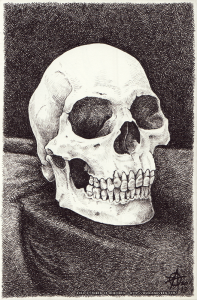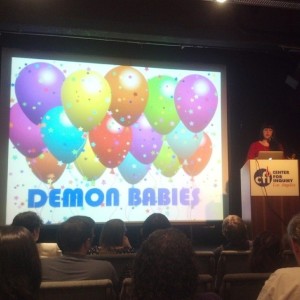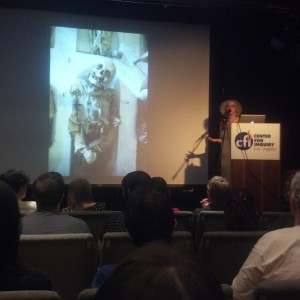 When I first heard about Death Salon, it had my immediate curiosity. I hadn’t finished reading all of the information on it before I made up my mind to attend. I could go into the details of WHY I wanted to go, but some of those are quite personal, and neither here nor there. The point is, I went, and it was amazing.
When I first heard about Death Salon, it had my immediate curiosity. I hadn’t finished reading all of the information on it before I made up my mind to attend. I could go into the details of WHY I wanted to go, but some of those are quite personal, and neither here nor there. The point is, I went, and it was amazing.
I heard about Death Salon via the Order of the Good Death (which I in turn heard about via Jezebel via a roundup of interesting Gawker media posts). The Order of the Good Death hosts some AMAZING blog posts about death, death culture, history of death and mortuary practices, and all sorts of other fascinating morsels. Order founder Caitlin Doughty is behind the infamous “Ask a Mortician” series, wherein she answers all kinds of questions about death and its trappings (go and watch a couple of episodes; I’ll wait).
Are you back? Okay, good…
[CAUTION: Frank and detailed discussion of death lies ahead; links may or may not be NSFW, and may contain graphic images. Reader discretion advised.]
My Death Salon experience kicked off on Friday, October 18th, with the Death Salon Cabaret at the Bootleg Theater on the outskirts of downtown Los Angeles. It wasn’t the most pleasant neighborhood for a lone public transit passenger, but the venue was otherwise suitably creepy, if a bit small and cramped for the crowd that ultimately turned up. The event room was packed with standing attendees (there was a marked lack of seating), which gave my introvert-self cause to grab a tasty ginger beer and retreat to the back room by the restrooms until I adjusted to the close quarters. I also went back later to partake of the vintage photo booth (though I came out looking a bit wild-eyed, like something Lovecraftian was holding the camera).
Things kicked off with some opening comments by Ms. Doughty, and then launched right into the series of mini lectures and musical interludes. The portions that struck me the most were the slideshow presented by Paul Koudounaris, author of Empire of Death and Heavenly Bodies, the musical interlude presented by Jill Tracy, a bit of death history from Lindsey Fitzharris, and a brief commentary on the curious fates of famous corpses by Bess Lovejoy, author of Rest in Pieces.
Dr. Koudounaris struck me visually as much as I was amazed by the material he presented. The gentleman had the most spectacular hat in attendance that evening, and looked every inch the artist. This was a man who piqued my curiosity, and then held it with the amazing photos he presented from his book, Heavenly Bodies. A framed print of one of his photographs was being raffled that evening. I was both sad and relieved I didn’t win; sad because it was a GORGEOUS photo. Relieved because in all honesty, what little wall space I have left is on reserve for the Gargoyles lithograph my uncle Jim is framing for me. …What? Why are you looking at me like that?
Moving on… Jill Tracy was a musical feast. The stories behind her music made it a real treat to listen to. I think my favorite piece was the lullaby she wrote to “Mermaid Baby No. 17,” inspired by one of the residents of the Mütter Museum in Philadelphia (which is now on my list of bucket list destinations, along with the Frazetta museum, also in Pennsylvania). While listening to Ms. Tracy’s music, I felt like I was shoulder to shoulder with my fellow misfits in a dark speakeasy. It was a fantastic bit of musical time travel. She’s a wonderful musician storyteller, and absolutely worth a listen.
Listening to Ms. Lovejoy discuss the fates of famous corpses got me to thinking about my great-grandmother, Eunice Murray. To that end, I’ve started opening dialogues with some of my relatives, mining for memories and stories about Eunice. Eunice was the housekeeper and companion of Marilyn Monroe before she died, and (or so I’m told) the one who found the body. It doesn’t surprise me that there are a lot of theories about her involvement in Monroe’s death. Sadly, whatever truth she knew about that went with her to the grave. What the Wikipedia article fails to mention is that Eunice was diagnosed with Alzheimer’s disease, and was pretty far gone by the time of her death at age 92 in 1994 (I was 12 or 13 at the time). I’d like to write more about her at a later date, when I have more details and thus more of a story to share.
To finish off the evening, I purchased a copy of Ms. Lovejoy’s book (which I shyly asked her to sign), and introduced myself to Ms. Doughty. After that, it was all over but for to wait for a my friend Natalie to pick me up. The evening ended with a viewing of the first episode of “Vikings” at her place.
I attended the Saturday events on the 19th at the Center for Inquiry West with Natalie (of Fatshionelle). Saturday was the “Morbid Anatomy Day,” wherein the speakers were contributors to the forthcoming Morbid Anatomy Anthology (which I was dumb and forgot to pre-order, so I’ll have to snag it when it comes out in February 2014). The day’s theme was “The Uncommon Corpse.”
Ms. Doughty treated us to a lecture on the conspicuous absence of “demon babies” from the historical record, following Medieval accusations of women shagging demons (because, you know, OMG witches!). The “explanation” boiled down to “(succubi + men) x metamorphosis + incubi + women = metaphysical sperm transfer.” No, really. (The SCA Medievalist in me LOVED this bit in particular.)
We were also treated to some select screenings from the Midnight Archive, which I HIGHLY recommend visiting online.
Dr. Koudounaris returned (in the same spectacular hat) to discuss some of the death rituals he has encountered in his travels, with a focus on the Fiesta de las Ñatitas in Bolivia. You can read about the fiesta in his article for the Fortean Times.
Evan Michelson of “Oddities” discussed her journey to the catacombs of Palermo, and the photography adventure that she had there with a friend. She showed us some of her own as well as historical photographs of the catacombs and the residents there. She spoke of the place with such amazing reverence and excitement that it was hard not to be entranced by what she had to say.
Of particular interest to me as an artist was Colin Dickey‘s discussion of St. Bartholomew, and the depictions of the saint in art. Mind you, ALL of the lectures were amazing, but Mr. Dickey’s was the first lecture which presented familiar material. He discussed classical portrayals of the saint in art, and paid special attention to Michelangelo’s The Last Jugment. I was almost bouncing in my seat, hoping that Mr. Dickey’s comments would address the theory that Michelangelo’s depiction of St. Bartholomew includes what is thought to be the artist’s self portrait–as the saint’s flayed skin. When this WAS mentioned, I did a little dance inside my own head.
However, the end to the afternoon block of lectures was the most spectacular by far. Allison de Fren discussed the works of (in)famous German anatomist Dr. Gunther von Hagens, who is renowned for the plastination technique of preserving cadavers, which can be seen in the “Body Worlds” exhibitions. I was able to attend one of the “Body Worlds” exhibitions in Los Angeles a few years ago, and I hope I have a chance to repeat the experience. de Fren’s presentation included a clip from a BBC series called “Anatomy for Beginners,” wherein von Hagens dissected a cadaver for a live audience. The clip showed the removal of the entirety of the subject’s skin, which was the first step in the dissection process. This was NOT a display for the faint of heart. I watched intently. What struck me the most were the SOUNDS. There were no punches pulled, as you could hear the various squishing noises, and the sound of the knife scraping against bone. I really REALLY want to see the entire series, now.
In an interview about Death Salon (starts at 21:00), Ms. Doughty commented:
I’d like them to take away a sense that they want to do more with death; they want to move forward with their relationship with death and their interest in death, in their reading, in their consumption of death culture.
A lot of the things that we talk about are kind of esoteric or historical or interesting in that way. But they’re kind of a gateway drug to get you to go home and actually think about your own practical mortality in the here and now: drawing up a living will, talking to your family bout what you want with your funeral plans. So making death interesting and accessible acts as a gateway to more practical things in your own life.
I think that sums it up rather nicely. When I would talk to my friends and coworkers about Death Salon and how excited I was to be going to this event, I got more than a few odd glances, and even fewer were bold enough to ask about what the event actually was. It’s not necessarily about celebrating or rejoicing in death. Rather, it’s about facing the inevitability of death and viewing it in a more practical light. For a lot of people, death is a hugely terrifying thing. A common way to make something less scary is to learn more about it, or in some cases, to make light of it and laugh at it. That’s what Death Salon is about.
I come at it from a couple of practical angles of my own. On the one hand, I’m a history geek (thank you, Society for Creative Anachronism), so studying death customs are a bit relevant to my interests there; in particular because I’m interested in “early period” cultures, such as the Celts and Vikings. Much of what we know about them is gleaned from what their remains tell us. On the other hand… Hey. I’m an artist. Human (and animal, really) anatomy is EXTREMELY relevant to what I do. Much of what we know about anatomy we owe to the anatomists of yore and the pioneering work they did with human dissection.
I already mentioned my desire to learn more about my great-grandmother. In addition to that, I find myself wanting to do more research into Celtic and Viking-age death customs and culture, and to learn more about the representation of death in art–both historical and contemporary. This strikes me as utterly fascinating.
As for myself, I’d like to be reduced to crumbs and subsequently added to concrete or bronze and cast as a gargoyle statue, then placed where I can stand watch in perpetuity. No, seriously. …Why are you looking at me like that??
Anyway… I’d like to round out this entry with a run-down of my Death Salon swag:
Counter-clockwise from top left:
- Two Morbid Anatomy postcards
- Postcard advertising Beyond the Dark Veil: Post Mortem and Mourning Photography from the Thanatos Archive
- Postcards advertising upcoming Heavenly Bodies events
- Paul Koudounaris at the Glendale Central Library Auditorium, Wednesday, October 30, 7 PM
- Photo exhibit opening and book signing; Friday, November 1, 8PM at La Luz de Jesus Gallery
- Morbid Anatomy Museum postcard
- Jill Tracy sticker and postcard
- Photo booth picture strip
- Rest in Pieces by Bess Lovejoy (signed)
- Lapham’s Quarterly Death issue (irony: the image of Lincoln on the cover is NOT a death mask, but cast from one of the two life masks made in his lifetime)
- Morbid Curiosity magazine #10





